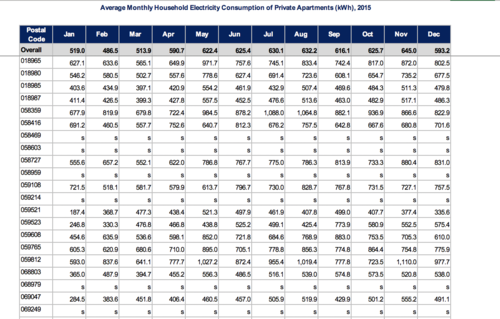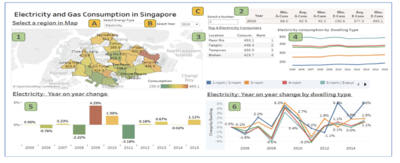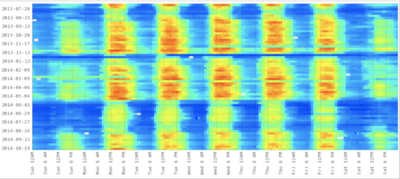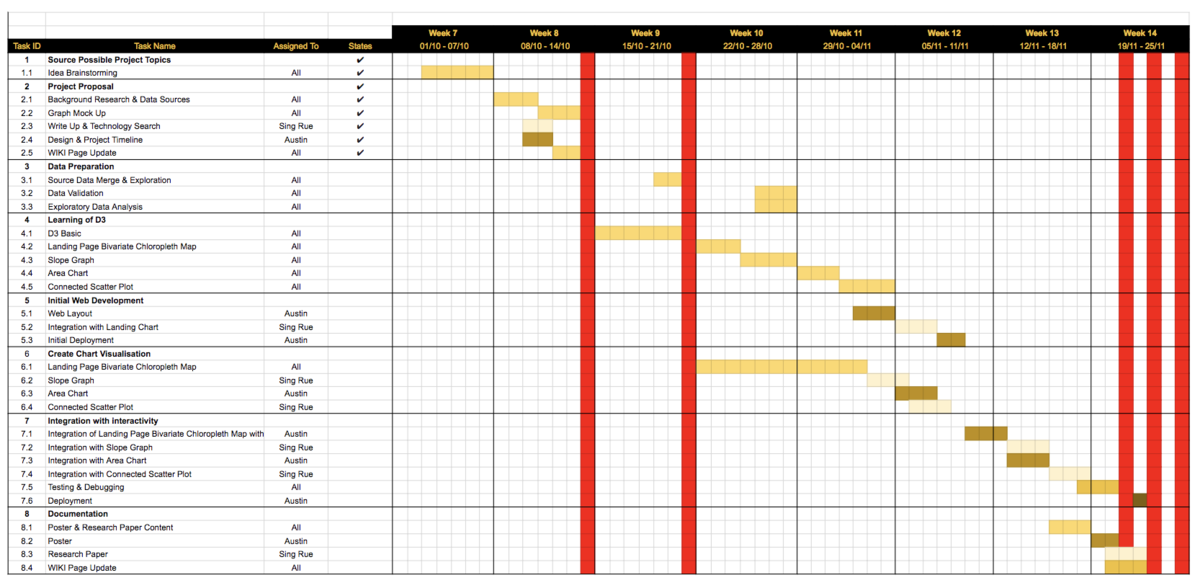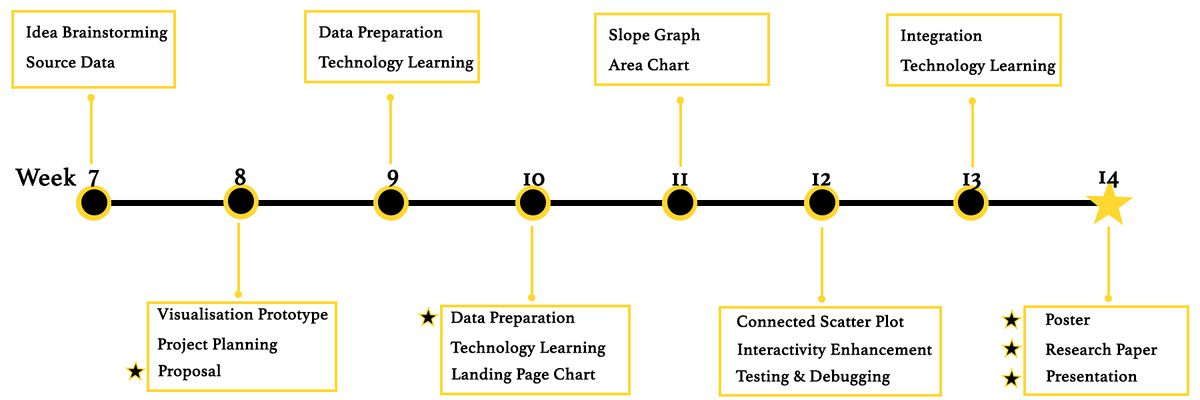Motivation
Household electricity consumption in Singapore has increased by about 17% over the past decade, according to a report by the National Environment Agency in May 2018. On aggregate levels, Singapore households consumed 7,295 GWh (gigawatt hours) in 2017, which roughly translates to an average expenditure of $1,000 a year on electricity per household.
Electricity consumption is a national issue, especially given that Singapore has finite energy sources. It is therefore important to encourage households to consume electricity in more sustainable ways.
Traditionally, the lack of transparency surrounding electricity use has been acknowledged as a possible challenge in raising awareness on electricity consumption. Improving visualisation of household electricity consumption can help people in Singapore gain better clarity of their consumption habits and expenditure, and thus more incentive to reduce electricity usage.
Our project visualises the distribution of household electricity consumption across planning regions in Singapore, accounting for type of residential homes, income and demographic profiles. We aim to better communicate electricity consumption in everyday life to people in Singapore, and ultimately engage them to reduce electricity consumption.
Objectives
Data
| Datasets
|
Data Attributes
|
Rationale Of Usage
|
EMA Household Energy Consumption
Source: https://www.ema.gov.sg/Statistics.aspx
|
- Postal Code (2013-2016)
- Room Type
- Month
- Electricity Consumption
|
There are 2 group of dataset. 1. Household Energy consumption
|
Bus Stop Names and Locations
(https://www.mytransport.sg/content/mytransport/home/dataMall.html#)
|
- Bus Stop Number
- Bus Stop Roof Number
- Bus Stop Name
- X
- Y
- Latitude
- Longitude
|
This dataset aims to complement the main dataset by providing detailed information about the latitude and longitude of the bus stops located around HDB. We use a javascript geocoding script to convert all the X and Y coordinates to EPSG:4326 latitude and longitude coordinates.
|
Mrt Stations Names and Locations
(https://www.mytransport.sg/content/mytransport/home/dataMall.html#)
|
- MRT Station Number
- MRT Station Name
- X
- Y
- Latitude
- Longitude
|
This dataset aims to complement the main dataset by providing detailed information about the latitude and longitude of the MRT stations located around HDB. We use a javascript geocoding script to convert all the X and Y coordinates to EPSG:4326 latitude and longitude coordinates
|
Master Plan Subzone Boundary Names and GeoPolygon
(https://data.gov.sg/dataset/master-plan-2014-subzone-boundary-no-sea)
|
- Polygon
- Name
- Subzone Number
- Subzone Code
- Region Name
- Area Code
- Area Indicator
|
This dataset aims to complement the main dataset by providing detailed information about all the subzone in Singapore. We use a javascript library toGeoJson.js to help us convert .KML file to .GeoJson file
|
Related Works
| Related Works
|
What We Can Learn
|
|
Dashboard Visualisation of Average Monthly Household Energy Consumption Per Year in Singapore
Source: https://analyticsandintelligentsystems.wordpress.com/2017/04/28/dashboard-visualisation-of-average-monthly-household-energy-consumption-per-year-in-singapore/
|
|
| Prediction of Buildings Energy Consumption
Source: http://cs109-energy.github.io/building-energy-consumption-prediction.html
|
|
| An interactive visualization of house prices along MRT stations
Source: https://www.srx.com.sg/mrt-home-prices/property-listings-near-east-west-line
|
- This visualization makes use of unique ways to illustrate the relation between nearby facilities and house prices. Thus in a glance, a person can tell where are the expensive areas based on the MRT stations.
- The separating of the various MRT lines using filters at the top prevent too much information from being shown in one page
- However, this chart could be too high level and general. Illustrating this on the Singapore map would be more useful instead, where each house's proximity to the MRT station and their respective resale price is shown. Also, in order to drill down, you would have to navigate to another page and then search for a specific house based on a table view which does not help one visualize where the resale flat is actually located at.
|
| Four Ways to Slice Obama’s 2013 Budget Proposal
Source: http://www.nytimes.com/interactive/2012/02/13/us/politics/2013-budget-proposal-graphic.html
|
- This visualization makes use of unique ways to illustrate Obama's Budget Proposal
- The various circles denote the various types of proposed budget items and the circles are sized based on the proposed budget amount.
- Users can toggle the links to slice and dice the initial visualization into different views so that a user can get different insights from the same initial visualization.
- This chart is very interesting and it is something that we wanted to use to present the changes in resale prices based on different flat types. If we have the time, we could do different filters as well but for now, we will try doing it for flat-type.
|
| OneMap Visualization of resale flat prices
Source: https://www.onemap.sg/main/v2/propertyquery
|
- This is a screenshot of an implementation of a interactive map by OneMap which allows users to search for resale flats on the map and view information related to the selected flat easily.
- We found this very good as it was very informative if you only wanted to look at one flat.
- However, the map looks very ugly and out-dated in terms of style and coloring and this map does not allow one to easily do comparisons between flats.
|
Prototype
Landing Page

[1]Logo
[2]Bivariate Chloropleth Map
[3]Filter
[4]Button to Historical Trend Page
[5]Slope Graph
Historical Trend Page

[1]Area Chart for Total Electricity Consumption
[2]Area Chart for Number of Singapore Resident
[4]Rate of Change of Number of Singapore Resident and Total Electricity Consumption
[3]Connected Scatter Plot
Project Schedules
Project Schedule on Google Sheet:https://docs.google.com/spreadsheets/d/1IlT3Na8Ujlv9izY-0PWvCWEWzfqOmzq3jGHIbWCDiwk/edit?usp=sharing
Challenges
| Challenges
|
Possible Solutions
|
|
Unfamiliar with D3.js
|
- Independent learning through online learning resources
- Validating learning outcome through review and coding practices
|
Data Merge, Cleaning and Transformation
|
- Subzone energy usage data:
- Missing NA records: government have purposedly removed some data points to enforce the data privacy. We will be examine the effect of remove the NA and decide the appropriate action to take.
|
Choice of web hosting provider
|
- A quick production pipeline required due to the time limit
- Examine the requirement of the data visualisation: dynamic or statics
- Current solution is to use Github Page as a hosting provider there is no dynamic data retrieval required
|
Unfamilar with implementation efforts required for customized D3.js interactivity
|
- The week will be spending 2 weeks to familiarize with D3.js structure & syntax
- Follwing 2 weeks will be trying out the customized D3.js interactivity
- The project scope and plan will be re-examined based on the project objective, complexity and time available
|
References
[1] Energy Market Authority (https://www.ema.gov.sg/singapore_energy_statistics.aspx)
[2] Data Gov Database (https://data.gov.sg)
[3] D3.js (Documentation https://d3js.org/)
[4] Observalehq (https://beta.observablehq.com/)
[5] One Map (https://www.onemap.sg/main/v2/)
[6] Energy Consumption Predition Example (http://cs109-energy.github.io/building-energy-consumption-prediction.html)
Feedback
Please feel free leave your comments, suggestions or anything interesting :)



